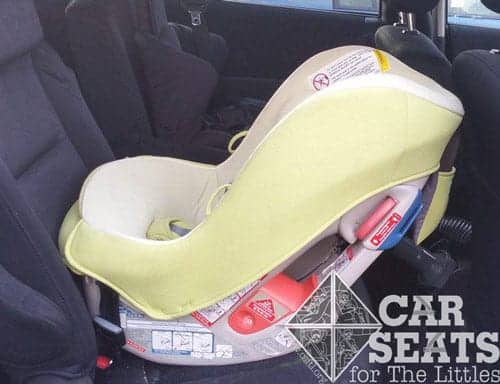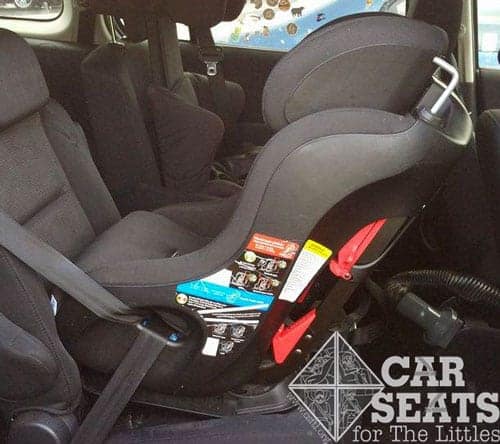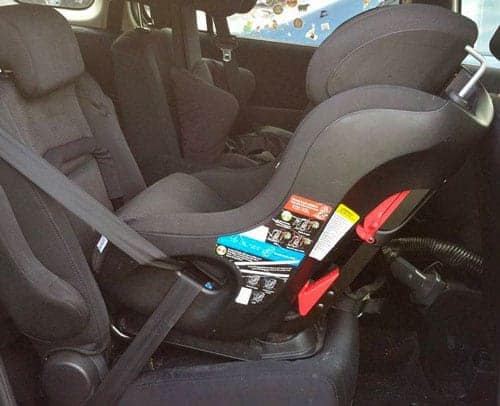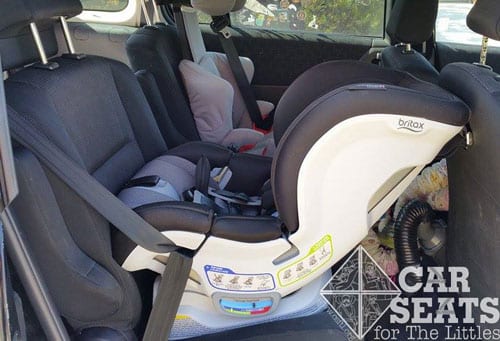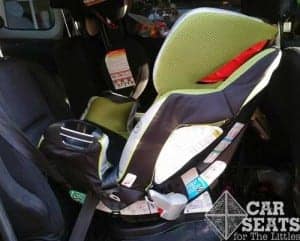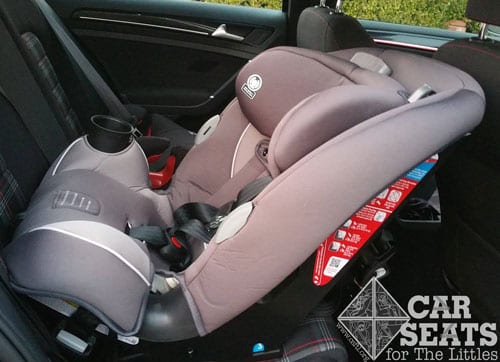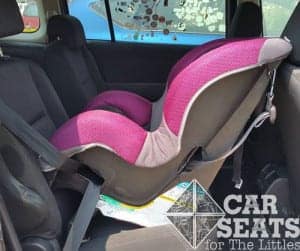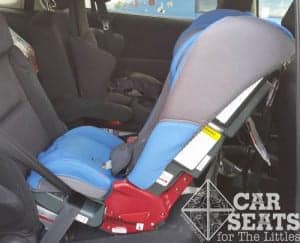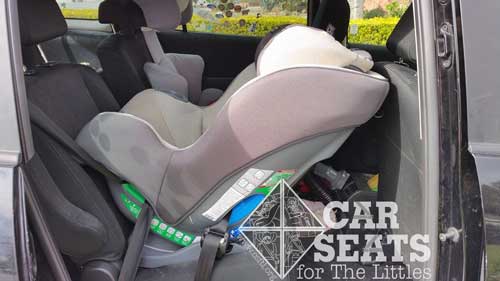If you’ve spent any time on our Facebook group, you might know that we’re big fans of the Safety 1st Advance EX 65 Air + convertible car seat. Why? It has a 50 pound rear facing weight limit, making it the most reasonably priced convertible seat with a weight limit that high. Take a closer look at this seat in our review.
The only catch about this well-featured seat is that it has a pretty large footprint. We field a lot of questions about possible seating locations in various vehicles where this seat might fit. While we can’t offer pictures of the Advance EX 65 Air + in every possible car, we can offer a bit of a size comparison pictorial.
To offer a sense of how this seat compares to other seats on the market in terms of size, we’ve asked many of the most popular convertible and multimode car seats available today to pose for this comparison article. Most of the seats you’ll see below were installed rear facing in a 2009 Mazda 5, others were installed in a 2016 VW GTI. The Mazda has captains chairs in the second row, so front-to-back space is generally not an issue.
The seats are listed in order from smallest front to back footprint to largest.
Important Note: the measurements taken for this article apply to my lovely 2009 Mazda 5 and my fabulous 2016 VW GTI on rare days when they were vaccummed. The car seats were installed at the most reclined position allowed in the Mazda’s 2nd row with the vehicle seat back reclined one click from the most upright position. The GTI’s vehicle seats are immovable. Please take these measurements with a grain of salt — there’s sure to be a bit of a variance between vehicles.
Combi Coccoro
At 27 inches front to back, the Combi Coccoro has the smallest front to back footprint of any of the seats we’ll compare in this article. It’s a short-lived car seat but might be a nice option for tall parents who need to push their vehicle seats back quite a bit.
Graco Contender
Next, we see the Graco Contender. When the headrest is below the shell, as it would be for younger, smaller Littles, the seat is roughly 29 inches front to back. As seen here, the headrest is fully extended to represent a child at the top end of the height limit for this seat. At this point, the Contender also measures roughly 34 inches front to back.
Clek Fllo without Anti-Rebound Bar
This is the Clek Fllo without the Anti-Rebound Bar attached. It measures a fairly petite 29 inches front to back.
Clek Fllo with Anti-Rebound Bar
The Clek Fllo can be installed with or without the Anti-Rebound Bar. With the bar attached, the Fllo’s footprint is 31 inches front to back. That’s slightly larger than when the bar is not attached.
Graco Milestone
The Graco Milestone measures roughly 31 inches front to back when the headrest is below the shell. With the headrest fully extended, it measures roughly 35 inches but the front to back distance doesn’t change much as the headrest extends since the fully extended headrest is contained within the seat’s shell.
Britax ClickTight Convertible
Next up is the Britax Marathon ClickTight convertible seat. In the most reclined mode, this seat measures roughly 31 inches front to back. The seat is not touching the passenger seat in front of it.
Evenflo SafeMax
The Evenflo SafeMax has a rather large headrest — that’s part of the Rollover Tested protection. The seat has one recline angle for any rear facing passengers. When installed at this angle, it measures roughly 32 inches front to back in the 2016 VW GTI. We suspect that when installed in the 2009 Mazda 5 that’s also used for this comparison, it will be closer to the 31 inches that the similar Evenflo Symphony requires.
Evenflo Symphony
The Evenflo Symphony measures about 31 inches front to back. With the headrest fully extended, it’s about 35 inches. The front to back distance doesn’t change much as the headrest extends since the fully extended headrest is contained within the seat’s shell.
Britax G Series Convertibles: Marathon/Boulevard
Here we see a Britax Boulevard installed rear facing in the same location. With the headrest below the top of the shell, this seat measures roughly 31″ front to back in the most reclined position. When used for younger babies, the seat will need to be at this angle. As the child grows, the seat can be installed more upright — within a range of 30-45 degrees level to the ground.
Models of this seat made before 10/2014 are outgrown in rear facing mode when the child’s head is 1″ from the top of the shell of the seat. Since most children will outgrow the seat before the headrest extends beyond the shell, the 31″ measurement is accurate for the life of the seat. Models of this seat that are made after 10/2014, however, are outgrown when the child’s head is 1 inch below the extended headrest. Either way, the seat takes up roughly the same amount of front to back space since the headrest extends over the top of the shell.
Clek foonf
Next up is the Clek foonf. Front to back it measures roughly 32″ with the headrest fully extended. When the seat is used for younger children and the headrest is below the shell of the seat, that distance is about the same since the fully extended headrest is contained within the seat’s shell.
Safety 1st Continuum
This Safety 1st Continuum has a single recline line that must be level for a child who cannot sit unassisted. After a child can sit unassisted the seat may be more upright. When the recline line is level the seat measures roughly 32 inches front to back.
Safety 1st Easy Elite
The Safety 1st Easy Elite multimode car seat has 2 recline lines — the more reclined angle is for infants who weigh under 22 lbs. At this most reclined angle, the seat measures 32 inches front to back.
Evenflo SureRide
Our next seat model is the Evenflo SureRide (also known as the Titan 65). Front to back, it measures 33 inches. This seat can be installed at just one recline angle, so it will always be about this size when it’s rear facing.
Diono Rainier
Without Angle Adjuster
Here’s the Diono Rainier, installed without the angle adjuster. Front to back, it measures roughly 33 inches. The headrest does not extend very far past the top of the seat’s shell so it’s likely that the Rainier would remain roughly 33 inches as the child grows.
Diono’s angle adjuster is available for purchase separately from the car seat. It’s for use with children who can sit up unassisted and it makes a big difference in the amount of front to back space that the seat requires. With the angle adjuster, the Rainier took up roughly 30 inches of space.
Safety 1st Advance EX Air +
The Safety 1st Advance EX Air + can be installed at 2 angles — the more reclined angle for children who weigh under 22 pounds and a slightly more upright angle for children who weigh more than 22 pounds. Front to back, it takes up roughly 34 inches of space.
When the headrest is fully extended, the shell of the seat is still the bulk of the size of the seat so the front to back room is not dramatically different when this seat is adjusted for a newborn or a preschooler.
The Advance EX 65 Air + has two recline settings. The seat’s manual and labeling requires children who are less than 22 pounds to have the seat at the most reclined of the two. Here, the seat is installed at the more upright of the two angles.
Summary
When most of the seats shown here are installed for a younger child, the headrest would be below the shell of the seat. This allows for anywhere from 1-5 extra inches of front to back space. As the child grows, the headrest would be raised. This decreases the front to back space but since growth happens slowly, it’s sometimes easier for the caregiver who rides in front of the seat to adapt to the temporary decrease in seating area.

